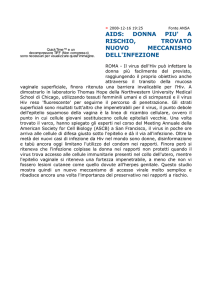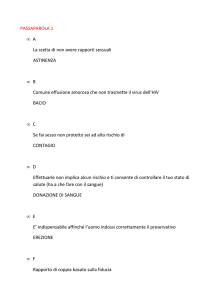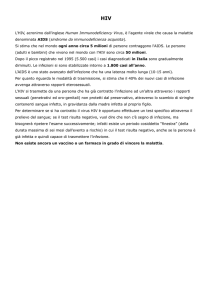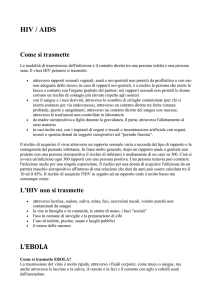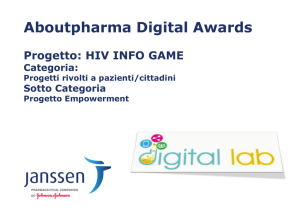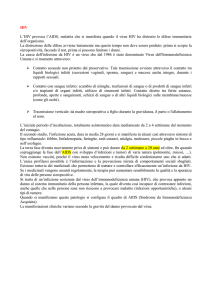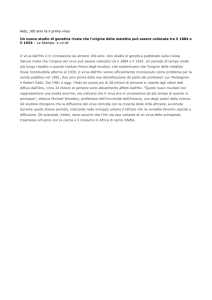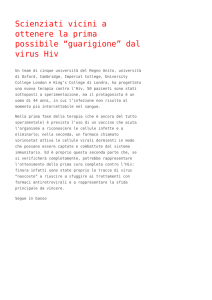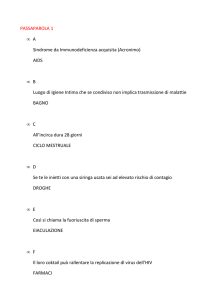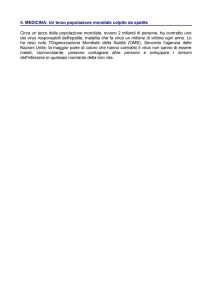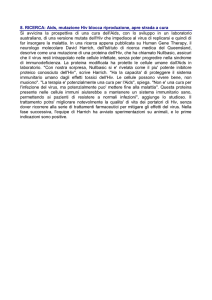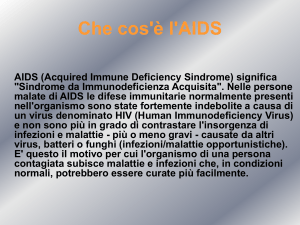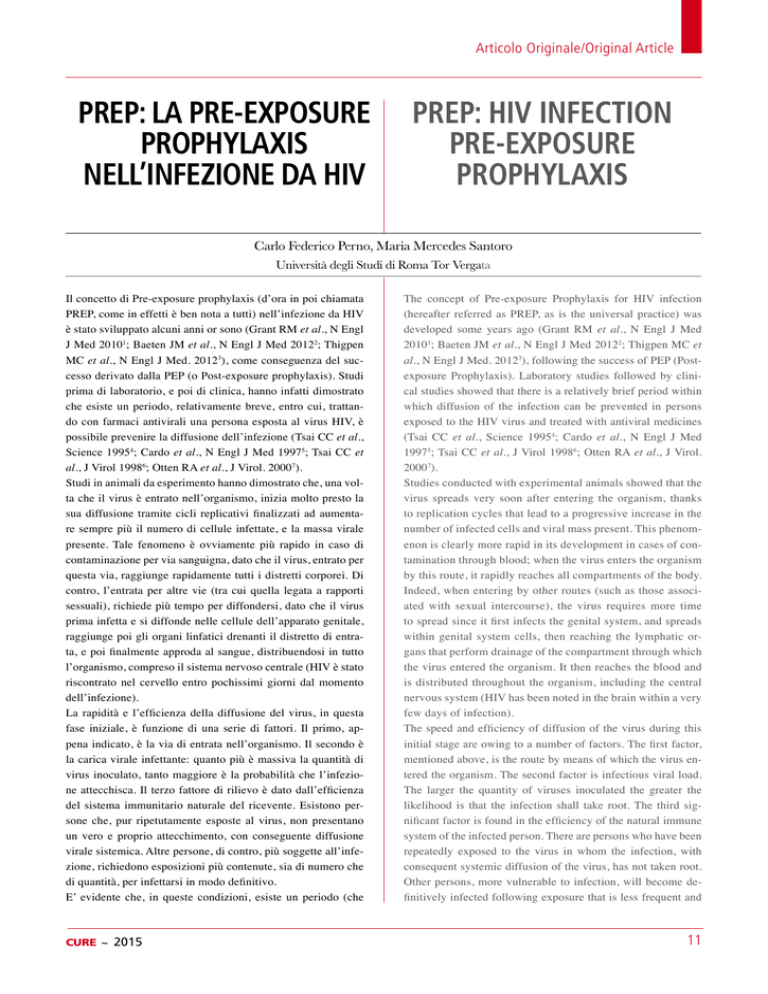
Articolo Originale/Original Article
PREP: LA PRE-EXPOSURE
PROPHYLAXIS
NELL’INFEZIONE DA HIV
PREP: HIV infection
pre-exposure
prophylaxis
Carlo Federico Perno, Maria Mercedes Santoro
Università degli Studi di Roma Tor Vergata
Il concetto di Pre-exposure prophylaxis (d’ora in poi chiamata
PREP, come in effetti è ben nota a tutti) nell’infezione da HIV
è stato sviluppato alcuni anni or sono (Grant RM et al., N Engl
J Med 20101; Baeten JM et al., N Engl J Med 20122; Thigpen
MC et al., N Engl J Med. 20123), come conseguenza del successo derivato dalla PEP (o Post-exposure prophylaxis). Studi
prima di laboratorio, e poi di clinica, hanno infatti dimostrato
che esiste un periodo, relativamente breve, entro cui, trattando con farmaci antivirali una persona esposta al virus HIV, è
possibile prevenire la diffusione dell’infezione (Tsai CC et al.,
Science 19954; Cardo et al., N Engl J Med 19975; Tsai CC et
al., J Virol 19986; Otten RA et al., J Virol. 20007).
Studi in animali da esperimento hanno dimostrato che, una volta che il virus è entrato nell’organismo, inizia molto presto la
sua diffusione tramite cicli replicativi finalizzati ad aumentare sempre più il numero di cellule infettate, e la massa virale
presente. Tale fenomeno è ovviamente più rapido in caso di
contaminazione per via sanguigna, dato che il virus, entrato per
questa via, raggiunge rapidamente tutti i distretti corporei. Di
contro, l’entrata per altre vie (tra cui quella legata a rapporti
sessuali), richiede più tempo per diffondersi, dato che il virus
prima infetta e si diffonde nelle cellule dell’apparato genitale,
raggiunge poi gli organi linfatici drenanti il distretto di entrata, e poi finalmente approda al sangue, distribuendosi in tutto
l’organismo, compreso il sistema nervoso centrale (HIV è stato
riscontrato nel cervello entro pochissimi giorni dal momento
dell’infezione).
La rapidità e l’efficienza della diffusione del virus, in questa
fase iniziale, è funzione di una serie di fattori. Il primo, appena indicato, è la via di entrata nell’organismo. Il secondo è
la carica virale infettante: quanto più è massiva la quantità di
virus inoculato, tanto maggiore è la probabilità che l’infezione attecchisca. Il terzo fattore di rilievo è dato dall’efficienza
del sistema immunitario naturale del ricevente. Esistono persone che, pur ripetutamente esposte al virus, non presentano
un vero e proprio attecchimento, con conseguente diffusione
virale sistemica. Altre persone, di contro, più soggette all’infezione, richiedono esposizioni più contenute, sia di numero che
di quantità, per infettarsi in modo definitivo.
E’ evidente che, in queste condizioni, esiste un periodo (che
CURE ~ 2015
The concept of Pre-exposure Prophylaxis for HIV infection
(hereafter referred as PREP, as is the universal practice) was
developed some years ago (Grant RM et al., N Engl J Med
20101; Baeten JM et al., N Engl J Med 20122; Thigpen MC et
al., N Engl J Med. 20123), following the success of PEP (Postexposure Prophylaxis). Laboratory studies followed by clinical studies showed that there is a relatively brief period within
which diffusion of the infection can be prevented in persons
exposed to the HIV virus and treated with antiviral medicines
(Tsai CC et al., Science 19954; Cardo et al., N Engl J Med
19975; Tsai CC et al., J Virol 19986; Otten RA et al., J Virol.
20007).
Studies conducted with experimental animals showed that the
virus spreads very soon after entering the organism, thanks
to replication cycles that lead to a progressive increase in the
number of infected cells and viral mass present. This phenomenon is clearly more rapid in its development in cases of contamination through blood; when the virus enters the organism
by this route, it rapidly reaches all compartments of the body.
Indeed, when entering by other routes (such as those associated with sexual intercourse), the virus requires more time
to spread since it first infects the genital system, and spreads
within genital system cells, then reaching the lymphatic organs that perform drainage of the compartment through which
the virus entered the organism. It then reaches the blood and
is distributed throughout the organism, including the central
nervous system (HIV has been noted in the brain within a very
few days of infection).
The speed and efficiency of diffusion of the virus during this
initial stage are owing to a number of factors. The first factor,
mentioned above, is the route by means of which the virus entered the organism. The second factor is infectious viral load.
The larger the quantity of viruses inoculated the greater the
likelihood is that the infection shall take root. The third significant factor is found in the efficiency of the natural immune
system of the infected person. There are persons who have been
repeatedly exposed to the virus in whom the infection, with
consequent systemic diffusion of the virus, has not taken root.
Other persons, more vulnerable to infection, will become definitively infected following exposure that is less frequent and
11
Articolo Originale/Original Article
chiameremo di latenza) che intercorre tra il momento in cui il
virus entra nell’organismo, e quello oltre il quale l’infezione
diviene definitiva e non più eradicabile. Questo periodo, variabile da persona a persona, e da situazione a situazione, è quello
in cui la PEP può intervenire, bloccando la diffusione del virus,
già entrato e replicante, determinando l’aborto dell’infezione.
Da un punto di vista biologico, si può tranquillamente dire che
la PEP favorisce una “guarigione” precoce di un’infezione ormai presente e attiva, dimostrando che, entro certi limiti, l’infezione da HIV è controllabile se presa in tempo utile. E’ un
approccio culturale non lontano da quello del cancro, in cui
la terapia antiblastica può eliminare in determinate circostanze
l’ultima cellula tumorale, favorendo la guarigione, e ciò accade
con tanta maggiore probabilità, quanto più precoce è stata la
terapia.
Queste conoscenze scientifiche riguardo l’inizio del percorso
infettivo di HIV, hanno permesso di mettere a punto, con notevole successo, i protocolli di prevenzione dell’infezione (PEP)
che, che, come appena detto, è un termine semanticamente sbagliato, in quanto si tratta più di guarigione precoce che di vera e
propria prevenzione dell’infezione. Oggi i protocolli per la PEP
sono codificati e comuni in tutto il mondo, e messi a disposizione, tramite la somministrazione di farmaci antivirali potenti,
alle persone che abbiano avuto un contatto altamente sospetto,
se non addirittura certo, con il virus, intervenendo entro poche
ore, massimo 48 (tale si ritiene il periodo finestra entro cui la
PEP funziona al meglio).
Il successo della PREP che, come detto, è una vera e propria
guarigione precoce, ha portato a ipotizzare che l’efficacia dei
farmaci antivirali possa essere ancor maggiore, nel prevenire
l’infezione, se somministrati effettivamente prima del contatto
con il virus. In questo caso, quando il virus raggiunge l’organismo, i farmaci sono già presenti a concentrazioni plasmatiche
e tessutali sufficienti da bloccare i primi cicli replicativi del
virus, rigettando l’infezione.
In questo caso, si parla di PREP, ossia esposizione ai farmaci
prima del contatto con il virus. E’ evidente che le probabilità
dei farmaci antivirali di agire sulla replicazione virale sono di
gran lunga maggiori se essi sono presenti prima che il virus
giunga nell’organismo.
Tale ipotesi di lavoro è stata ampiamente dimostrata in modelli
sperimentali, prima in vitro (cellule esposte ai farmaci prima
del virus hanno tassi di rigetto dell’infezione altissimi), e poi in
vivo. Scimmie di diverse specie, sottoposte ad un trattamento
profilattico con farmaci antivirali, e poi esposte al virus, hanno
mostrato tassi di rigetto dell’infezione estremamente lusinghieri, tali da giustificare studi nell’uomo.
E’ da sottolineare che non tutti i farmaci anti-HIV hanno un’efficacia simile nella prevenzione dell’infezione virale. Andreb-
12
on a smaller scale.
Clearly, in these conditions, there is a period (that we shall
call a latency period) between the moment in which the virus
enters the organism and the time following which the infection becomes definitive and is no longer eradicable. Varying
from person to person and from situation to situation, this is
the period in which PEP intervention is possible, in order to
block diffusion of the virus, that has already entered and that
is replicating itself, thereby aborting the infection. Biologically speaking, we may safely claim that PEP brings about
early “recovery” from an infection already present and active.
This proves that, to a certain extent, HIV infections can be
controlled if treatment is provided early enough. The cultural
approach is similar to that applying to cancer, where antiblastic therapy can, in certain circumstances, remove all tumour
cells, thus favouring recovery. The earlier the therapy is provided the more likely recovery shall be.
This scientific knowledge, regarding the early stages of HIV
infection, has enabled the remarkably successful application
of certain practices for prevention of infection (PEP). Semantically speaking, as we have already noted, this term is in error, since we have here early recovery rather than prevention
of infection. Nowadays, PEP procedures have been codified
and applied worldwide thanks to administration of potent
antiviral medicines to persons exposed to the virus and for
whom infection is either likely or certain. Treatment starts
up within hours, and at the latest within 48 hours of exposure
(this is the optimal time window for PEP effectiveness).
In view of the success of PREP (which we have defined as
early recovery in the true sense of the term) it was hypothesised that the efficacy of antiviral medicines is more marked
when these are administered before contact with the virus. In
this case, the medicines are already present in the plasma before the virus reaches the organism, and tissue concentrations
are high enough to block the initial replication cycles of the
virus, leading to rejection of the infection.
Here, we are dealing with PREP (i.e. exposure to medicines
before the contact with the virus itself). It goes without saying
that antiviral medicines will be much more likely to combat
viral replication effectively if they are present in the organism
prior to the arrival of the virus itself.
This working hypothesis received extensive confirmation in
various experimental models, initially in vitro (the rates for rejection of infection in cells exposed to the medicines before
contact with the virus were very high). In vivo work was then
carried out using various monkey species prophylactically
treated with antiviral medicines and then exposed to the virus.
The rejection rate for the infection was found to be most encouraging in these cases, indicating the suitability of studies
CURE ~ 2015
Articolo Originale/Original Article
bero infatti privilegiati quelli che, raggiungendo concentrazioni
metabolicamente attive nelle cellule bersaglio del virus, sono
in grado di bloccare le primissime fasi del ciclo replicativo cellulare. I primi studi sono stati svolti, con notevole successo, in
scimmie esposte a tenofovir (Tsai CC et al., Science 19954),
e infettate subito prima (in tal caso si parla di PEP) o subito
dopo (PREP) con HIV o il virus dell’immunodeficienza delle
scimmie (SIV, l’omologo di HIV nelle scimmie). Il trattamento
antivirale ha mostrato una sostanziale efficacia nel bloccare la
replicazione virale. Tra le scimmie trattate, solo alcune di esse
hanno progredito nell’infezione, contro tutte quelle esposte al
virus ma non trattate.
Un altro tipo di farmaci che potrebbero essere particolarmente
efficaci in questo ambito sono quelli che impediscono al virus
di legarsi alle cellule bersaglio, o di penetrare in esse. L’unico
farmaco potenzialmente utile in questo settore è il maraviroc.
Non sono peraltro disponibili studi che indichino se questo approccio sia o meno perseguibile.
Utile sarà la verifica della potenziale efficacia preventiva di altri farmaci, quali gli inibitori dell’integrasi, molto potenti ed
efficaci contro HIV. Anche in questo ambito, non vi sono studi
in grado di dare informazioni.
In sostanza, quindi, la PREP è una realtà concettuale, di grande
interesse per tutte le circostanze in cui la persona sia a rischio
di venire prossimamente a contatto con il virus. Restava da
identificare quali sono queste circostanze, e se effettivamente
la PREP è poi risultata efficace.
In tal senso sono stati fatti numerosi studi, focalizzati su popolazioni a rischio di infezione. L’esempio più evidente di queste situazioni sono i partner negativi di persone sieropositive,
a rischio continuo di venire infettati dal partner, specialmente
nel caso il partner non assuma farmaci antiretrovirali. Tale situazione è stata, ed è ancora una costante in molti contesti dei
Paesi in via di sviluppo.
Tra gli studi più importanti in tal senso, ricordiamo quello, preliminare, condotto da Myron S. Cohen, in cui sono stati trattati precocemente con terapia antivirale i soggetti sieropositivi
aventi un partner sieronegativo. Lo studio, pubblicato sul New
England Journal of Medicine, ha mostrato ben 39 infezioni del
partner sieronegativo in caso di trattamento tardivo (sotto i 350
CD4), contro 1 sola infezione del sieronegativo in caso di trattamento immediato (Cohen MS et al., New England Journal
of Medicine 20118). Ciò ha permesso di ottenere, tramite una
PREP ante-litteram, una riduzione della progressione di malattia nel sieropositivo, e una notevole, marcatissima, prevenzione
dell’infezione nel partner sieronegativo.
Il passo successivo è stato di trattare direttamente il sieronegativo a rischio. Sono stati effettuati tantissimi studi in tal senso,
alcuni basati sul trattamento orale con farmaci antivirali, alcuni
con somministrazioni locoregionali (vaginali, anali, ecc.) di prodotti topici contenenti farmaci antivirali oppure microbicidi.
CURE ~ 2015
with human beings.
We must note that, in preventing viral infection, not all antiHIV medicines are equally efficacious. The most indicated
medicines are those that, on reaching metabolically active
concentrations in the cells targeted by the virus, are capable
of blocking the very first stages of the cellular replication cycle. The first studies, using monkeys, were conducted with
considerable success. The monkeys were exposed to tenofovir
(Tsai CC et al., Science 19954), and were infected immediately beforehand (hence, PEP), or immediately after (PREP),
either with HIV or with the simian immunodeficiency virus
(SIV, the homologue of HIV in monkeys). Antiviral treatment
was found to be fairly efficacious in blocking viral replication. Progress of the infection was noted only in some of the
treated monkeys. Conversely, progress was noted in all monkeys exposed to the virus but left untreated.
Medicines of another type might be particularly efficacious
in this ambit, i.e. medicines that prevent the virus from binding with, or penetrating, target cells. Maraviroc is the only
medicine that may be efficacious within this field. However,
no studies are available in regard to the effective feasibility
of this approach.
Testing the preventive potentials of other medicines would be
of interest in this regard, such as integrase inhibitors, which are
markedly potent and efficacious anti-HIV agents. Here too, no
studies are available for information on this question.
The idea of PREP treatment is therefore of considerable interest wherever people are at imminent risk of coming into contact
with the virus. Questions remained regarding how we can pinpoint such situations and regarding the actual efficacy of PREP.
Many studies have therefore been conducted with the focus
on populations at risk of infection. The most notable cases
consist in seronegative partners of seropositive persons, who
are constantly at risk of infection from their partner, above all
when taking no antiretroviral medicines. This situation has
been, and remains, a constant in many developing countries.
In this regard, among the most important studies is the preliminary study by Myron S. Cohen in which early antiviral
therapeutic treatment was provided to seropositive persons
with seronegative partners. The study, published in the New
England Journal of Medicine, documented as many 39 infections of seronegative partners following late treatment (below
350 CD4) and only 1 infection of a seronegative person when
treatment was provided immediately (Cohen MS et al., New
England Journal of Medicine 20118). It was thus noted that,
through ante-litteram PREP, the disease’s progress was less
marked in seropositive patients and infection of seronegative
partners was very successfully prevented.
The next step consisted in direct treatment of seronegative
persons at risk. Here, very many studies have been conducted. Some were based on treatment with antiviral medicines
13
Articolo Originale/Original Article
I risultati ottenuti sono stati molto diversi tra loro. Al momento,
la PREP tramite somministrazione topica non sembra aver ottenuto risultati stabili e riproducibili. In alcuni casi, addirittura,
si è avuto un aumento dell’infezione in soggetti trattati con il
prodotto topico. Ciò sembra essere legato al veicolo del farmaco microbicida che, essendo proinfiammatorio e quindi avendo
favorito un’infiammazione loco-regionale, avrebbe richiamato
cellule immunitarie, inclusi linfociti CD4, aumentando indirettamente il rischio infettivo.
Anche i risultati della PREP con farmaci antiretrovirali somministrati per via orale non sono stati pienamente consistenti,
sebbene alquanto incoraggianti. In genere, il tasso di infezione
da HIV nel partner sieronegativo “profilassato” con la PREP
è stato minore rispetto a quello riscontrato in soggetti trattati
con placebo.
Sulla base di questi dati, la Food and Drug Administration
(FDA) americana ha autorizzato l’uso della profilassi PREP
con farmaci antivirali (tenofovir e emtricitabina) in particolari
condizioni di soggetti a rischio di infezione da HIV.
Una valutazione globale dei dati finora ottenuti indica che, se la
PREP ha un valore comunque straordinario nella prevenzione
di HIV, essa non rappresenta, ne’ può rappresentare un metodo
magico per garantire a tutti coloro che abbiano comportamenti a rischio di infezione la certezza di non infettarsi con HIV.
In tal senso vanno letti i risultati, recentemente presentati al
Congresso CROI di Seattle, riguardo il trattamento PREP di
soggetti omosessuali sieronegativi, ritenuti per comportamenti, ad altissimo rischio di infezione con HIV (McCormack S
and Dunn D, CROI 20159). Questo studio ha dimostrato una
riduzione sostanziale (fino all’86%) dell’infezione da HIV nei
soggetti che avevano assunto farmaci antivirali (tenofovir e
emtricitabina, come in altri studi) prima e subito dopo i rapporti a rischio. Da un lato, lo studio conferma appieno la notevole
efficacia di questo approccio “on demand” (ossia la PREP viene assunta in caso di previsione di comportamenti a rischio, e
non in maniera continuativa), sempre che i farmaci antivirali
vengano assunti in modo proprio e regolare tutte le volte che
si abbiamo comportamenti a rischio. Dall’altro, la PREP non
protegge nei confronti di altre infezioni a trasmissione sessuale. Dati ancora incompleti sembrano suggerire un aumento del
tasso di infezioni non HIV a carattere sessuale in questi pazienti con PREP (soprattutto sifilide, gonorrea, ecc.). Queste
infezioni non sono innocue, anche se di norma ben trattabili,
e pertanto il loro aumento, se fosse dimostrato, suggerirebbe
una minore attenzione nei comportamenti a rischio, “protetti”
da HIV (anche se non sappiamo fino a che livello), ma non da
altre patologie.
In conclusione, PEP e PREP mostrano che possiamo intervenire sull’infezione da HIV, e che più presto agiamo, maggiori
sono le probabilità di successo. Questo ragionamento conforta
e conferma la scelta di trattare precocemente tutti i pazienti con
14
administered by oral route. Locoregional (vaginal, anal etc.)
administration of topical products containing antiviral or microbicidal medicines was carried out in other studies.
The results varied greatly. Currently, it may be concluded that
the outcomes of PREP following topical administration are
neither stable nor reproducible. Indeed, in certain cases an increase in infection was noted among persons treated topically.
This may be due to the vehicle for the microbicidal medicine,
which is proinflammatory and which therefore may have favoured locoregional inflammation, attracting immune cells,
including CD4 lymphocytes, thereby indirectly augmenting
the risk of infection.
Again, in the case of oral route PREP treatment with antiretroviral
medicines, while fairly encouraging, the results were not entirely
consistent. Generally speaking, the rate of HIV infection of the seronegative partner subjected to PREP prophylaxis was lower than
in persons treated with the placebo.
On the basis of these data, the Food and Drug Administration
(FDA) in the United States authorised the practice of PREP prophylaxis based in antiviral medicines (tenofovir and emtricitabine),
in particular conditions for persons at risk of HIV infection.
A global assessment of the data obtained to date indicates that,
while PREP is, in any case, of extraordinary value as a means of
preventing HIV infection, it is not − nor can it be − considered
a magical potion fully safeguarding all persons whose conduct
places them at risk of HIV infection. This conclusion must guide
us in our understanding of the results recently presented at the
CROI Congress in Seattle concerning PREP treatment of seronegative homosexuals whose conduct indicates that they are very
greatly at risk of HIV infection (McCormack S and Dunn D,
CROI 20159). This study pointed to a considerable lowering (up
to 86%) of the HIV infection rate in persons treated with antiviral medicines (tenofovir and emtricitabine, as in other studies)
before and immediately after risk-bearing sexual activities. The
study fully confirmed the marked efficacy of this “on demand”
approach (i.e. PREP administered prior to risk-bearing conduct
and not administered on an ongoing basis), conditional upon correct administration of the antiviral medicines prior to all riskbearing conduct. However, PREP provides no protection against
other sexually transmitted diseases. Data which are still partial
seem to indicate an increase in the rate of non-HIV sexual infections in PREP patients (above all, syphilis, gonorrhoea etc.).
While not innocuous, these infections generally respond well to
treatment. Thus, as part of the risk-bearing conduct of persons
who are “protected” from HIV but not from other diseases (in
some measure, as yet unknown), the increase in incidence of
such cases, if proven, is of less concern to us.
By way of conclusion, we may note that PEP and PREP are potentially efficacious against HIV infection, and that the earlier
the treatment is provided the more efficacious it is likely to be.
This line of reasoning indicates that it is advisable that early
CURE ~ 2015
Articolo Originale/Original Article
infezione da HIV, indipendentemente dal loro stadio di malattia, assunta dalla stragrande maggioranza delle linee guida dei
Paesi sviluppati. PREP e PEP indicano anche che alcuni farmaci hanno particolari potenzialità antivirali, che altri non necessariamente hanno, o che comunque debbono dimostrare di avere (Krakower DS et al., Curr HIV/AIDS Rep. 201510). Il fatto
che tenofovir e emtricitabina siano l’associazione più utilizzata
in assoluto nella terapia antivirale di soggetti sieropositivi, è in
linea con, ed è confortata dai risultati della PREP. Nello stesso
tempo, un uso universalistico della PREP in soggetti a rischio
richiede ancora evidenze sia in termini di efficacia che di tossicità, senza contare l’importanza di una valutazione economica
e sociale dei costi aggiuntivi determinati da questo approccio.
Le basi sono state messe, urge acquisire altre conoscenze per
giungere a conclusioni clinicamente rilevanti e decisive.
treatment be provided to all HIV infected patients irrespective of
the stage of the disease. This approach is included in the vast majority of the guidelines issued in developed countries. PREP and
PEP also indicate that certain medicines have particular antiviral
potentials that are not necessarily found in other medicines or
that have yet to be confirmed in these other medicines (Krakower
DS et al., Curr HIV/AIDS Rep. 201510). In line with, and backed
up by, PREP results, tenofovir and emtricitabine provide, with
full justification, the most widely used association for antiviral
therapy in seropositive patients. However, for universal adoption
of PREP in persons at risk, efficacy and toxicity data have yet to
be acquired, over and above an economic and social assessment
of the added costs of this approach. The foundations have been
laid. Further information is absolutely necessary if decisive and
clinically significant conclusions are to be reached.
References
1. Grant RM, Lama JR, Anderson PL, McMahan V, Liu AY, Vargas L, Goicochea P, Casapía M, Guanira-Carranza JV, Ramirez-Cardich
ME, Montoya-Herrera O, Fernández T, Veloso VG, Buchbinder SP, Chariyalertsak S, Schechter M, Bekker LG, Mayer KH, Kallás
EG, Amico KR, Mulligan K, Bushman LR, Hance RJ, Ganoza C, Defechereux P, Postle B, Wang F, McConnell JJ, Zheng JH, Lee J,
Rooney JF, Jaffe HS, Martinez AI, Burns DN, Glidden DV; iPrEx Study Team. Preexposure chemoprophylaxis for HIV prevention
in men who have sex with men. N Engl J Med. 2010; 363(27):2587-2599.
2. Baeten JM, Donnell D, Ndase P, Mugo NR, Campbell JD, Wangisi J, Tappero JW, Bukusi EA, Cohen CR, Katabira E, Ronald A,
Tumwesigye E, Were E, Fife KH, Kiarie J, Farquhar C, John-Stewart G, Kakia A, Odoyo J, Mucunguzi A, Nakku-Joloba E, Twesi-
gye R, Ngure K, Apaka C, Tamooh H, Gabona F, Mujugira A, Panteleeff D, Thomas KK, Kidoguchi L, Krows M, Revall J, Morrison S, Haugen H, Emmanuel-Ogier M, Ondrejcek L, Coombs RW, Frenkel L, Hendrix C, Bumpus NN, Bangsberg D, Haberer JE,
Stevens WS, Lingappa JR, Celum C; Partners PrEP Study Team. Antiretroviral prophylaxis for HIV prevention in heterosexual men
and women. N Engl J Med. 2012; 367(5):399-410.
3. Thigpen MC, Kebaabetswe PM, Paxton LA, Smith DK, Rose CE, Segolodi TM, Henderson FL, Pathak SR, Soud FA, Chillag KL,
Mutanhaurwa R, Chirwa LI, Kasonde M, Abebe D, Buliva E, Gvetadze RJ, Johnson S, Sukalac T, Thomas VT, Hart C, Johnson JA,
Malotte CK, Hendrix CW, Brooks JT; TDF2 Study Group. Antiretroviral preexposure prophylaxis for heterosexual HIV transmission in Botswana. N Engl J Med. 2012; 367(5):423-434.
4. Tsai CC, Follis KE, Sabo A, Beck TW, Grant RF, Bischofberger N, Benveniste RE, Black R. Prevention of SIV infection in
macaques by (R)-9-(2-phosphonylmethoxypropyl)adenine. Science. 1995 Nov 17; 270(5239):1197-9.
5. Cardo DM, Culver DH, Ciesielski CA, Srivastava PU, Marcus R, Abiteboul D, Heptonstall J, Ippolito G, Lot F, McKibben PS,
Bell DM. A case–control study of HIV seroconversion in health care workers after percutaneous exposure. N Engl J Med. 1997;
337:1485–90.
6. Tsai CC, Emau P, Follis KE, Beck TW, Benveniste RE, Bischofberger N, Lifson JD, Morton WR. Effectiveness of postinoculation
(R)-9-(2-phosphonylmethoxypropyl) adenine treatment for
7. prevention of persistent simian immunodeficiency virus SIVmne infection depends critically on timing of initiation and duration of
treatment. J Virol. 1998 May;72(5):4265-73.
CURE ~ 2015
15
Articolo Originale/Original Article
8. Otten RA, Smith DK, Adams DR, Pullium JK, Jackson E, Kim CN, Jaffe H, Janssen R, Butera S, Folks TM. Efficacy of postexposure
prophylaxis after intravaginal exposure of pig-tailed macaques to a human-derived retrovirus (human immunodeficiency virus type
2). J Virol. 2000 Oct; 74(20):9771-5.
9. Cohen MS, Chen YQ, McCauley M, Gamble T, Hosseinipour MC, Kumarasamy N, Hakim JG, Kumwenda J, Grinsztejn B, Pilotto
JH, Godbole SV, Mehendale S, Chariyalertsak S, Santos BR, Mayer KH, Hoffman IF, Eshleman SH, Piwowar-Manning E, Wang
L, Makhema J, Mills LA, de Bruyn G, Sanne I, Eron J, Gallant J, Havlir D, Swindells S, Ribaudo H, Elharrar V, Burns D, Taha TE,
Nielsen-Saines K, Celentano D, Essex M, Fleming TR; HPTN 052 Study Team. Prevention of HIV-1 infection with early antiretroviral therapy. N Engl J Med. 2011 Aug 11; 365(6):493-505. doi: 10.1056/NEJMoa1105243. Epub 2011 Jul 18.
10. McCormack S, Dunn D. Pragmatic Open-Label Randomised Trial of Preexposure Prophylaxis: The PROUD Study. Conference on
Retroviruses and Opportunistic Infections 2014. February 23-26, 2015, Seattle, Washington. Abstract 22LB.
11. Krakower DS, Jain S, Mayer KH. Antiretrovirals for Primary HIV Prevention: the Current Status of Pre- and Post-exposure Prophylaxis. Curr HIV/AIDS Rep. 2015 Mar;12(1):127-38. doi: 10.1007/s11904-014-0253-5.
16
CURE ~ 2015

